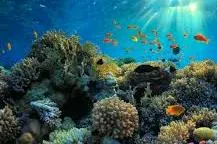What exactly happens to coral during a bleaching event?
Recently, researchers in Australia employed a microscope, camera and smart tablet to find out how the organisms respond to heat stress. It's the first time scientists have filmed the behaviors specific to bleaching.
The filmed experiments were conducted in an aquarium, where researchers could manipulate water temperature. Solitary specimens of the coral species Heliofungia actiniformis were subjected to spikes in water temperature.
As revealed by the videos, the corals used a pulsed inflation mechanism to expel their algal companions. When healthy, Heliofungia actiniformis houses Symbiodinium, tiny algae cells.
The microorganisms are what give coral their color. Coral offer the algae protection in exchange for fuel rendered via photosynthesis.
Scientists described their new bleaching videos this week in the journal Coral Reefs.
"What's really interesting is just how quickly and violently the coral forcefully evicted its resident symbionts," Brett Lewis, a researcher at the Queensland University of Technology, said in a news release. "The H. actiniformis began ejecting the symbionts within the first two hours of us raising the water temperature of the system."
The expelled symbionts appear as green plumes in the videos. To kick out their tenants, the coral expands its volume by as much as 340 percent before quickly shrinking back to normal size. Corals repeated the routine of expansion and contraction every four to eight days during the bleaching experiment.
On the Great Barrier Reef, H. actiniformis has proven remarkably resilient to heat stress as compared to neighboring species. Scientists believe its ability to quickly shed its algal inhabitants may aid its ability to survive bleaching events.
More research is needed to understand the benefits and risks of rapid algal expulsion.
"If the Symbiodinium is removed from the host and does not recolonise quickly, the corals can die," said Luke Nothdurft from QUT's marine facility. "Mass coral bleaching events are a concern for scientists globally with recent events on the Great Barrier Reef highlighting the threat of elevated water temperatures to the heath of reef ecosystems."
[upi.com]
12/8/16
--
-
Related:
-

Recently, researchers in Australia employed a microscope, camera and smart tablet to find out how the organisms respond to heat stress. It's the first time scientists have filmed the behaviors specific to bleaching.
The filmed experiments were conducted in an aquarium, where researchers could manipulate water temperature. Solitary specimens of the coral species Heliofungia actiniformis were subjected to spikes in water temperature.
As revealed by the videos, the corals used a pulsed inflation mechanism to expel their algal companions. When healthy, Heliofungia actiniformis houses Symbiodinium, tiny algae cells.
The microorganisms are what give coral their color. Coral offer the algae protection in exchange for fuel rendered via photosynthesis.
Scientists described their new bleaching videos this week in the journal Coral Reefs.
"What's really interesting is just how quickly and violently the coral forcefully evicted its resident symbionts," Brett Lewis, a researcher at the Queensland University of Technology, said in a news release. "The H. actiniformis began ejecting the symbionts within the first two hours of us raising the water temperature of the system."
The expelled symbionts appear as green plumes in the videos. To kick out their tenants, the coral expands its volume by as much as 340 percent before quickly shrinking back to normal size. Corals repeated the routine of expansion and contraction every four to eight days during the bleaching experiment.
On the Great Barrier Reef, H. actiniformis has proven remarkably resilient to heat stress as compared to neighboring species. Scientists believe its ability to quickly shed its algal inhabitants may aid its ability to survive bleaching events.
More research is needed to understand the benefits and risks of rapid algal expulsion.
"If the Symbiodinium is removed from the host and does not recolonise quickly, the corals can die," said Luke Nothdurft from QUT's marine facility. "Mass coral bleaching events are a concern for scientists globally with recent events on the Great Barrier Reef highlighting the threat of elevated water temperatures to the heath of reef ecosystems."
[upi.com]
12/8/16
--
-
Related:
-


No comments:
Post a Comment
Only News